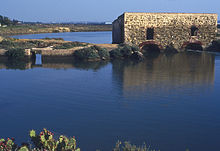Tide mill
A tide mill (more rarely also called a tide mill or flood mill ) is driven periodically by ebb and flow on coasts with sufficient tidal range . It is related to conventional water mills .

functionality
Tide mills were usually located in the mouths of tidal rivers , far enough from the sea to avoid negative effects of the waves and close enough to take advantage of the tidal range. A flooded area or part of an estuary was turned into a reservoir by a dam with a lock . The tide flows through the lock, which closes automatically when the tide drops, into the mill pond. When the water level is low, the pent-up water can flow back over the mill wheel.
distribution
Tide mills occur in Europe on the coasts of the Atlantic between the British Isles and Portugal (Alhos Vedros, Alqueidão (Figueira da Foz), Corroios, Mourisca, Olhão). The earliest archaeologically documented tide mill to date was discovered on the grounds of Nendrum Monastery on an island in Strangford Lough in Northern Ireland . It has been dendrochronologically dated to 619–621 AD. Their millstones have a diameter of 830 mm, and the horizontal wheel could develop a peak power of about 0.65 kW. A similar old mill (from the year 619) is mentioned in the " Domesday Book " (1086) and stood in the port of Dover . It is possible that the power of the tides was used in England (4 mills) and France (around 70 moulin à marée) as early as the 6th century. It is unlikely that they were already used by the Romans , as the Mediterranean cultures did not encounter a tidal situation.
In the early Middle Ages they were used to grind grain or spices , and later also to drive hammer and sawmills in the paper and fabric industry. The tide mills at Yellow Walls near Malahide in County Fingal in Ireland also date from this period . The Cave Marsh tide mill is one of four near the Broad Estuary. The others are Kilcrea, Lissenhall Great, and Ballymadrough / Seapoint.
United Kingdom
England
In the UK , four tidal mills have been preserved:
- the Carew Tidal Mill in Wales , now a museum
- in Woodbridge near Ipswich
- in Eling and Lymington near Southampton
- on the River Lea in East London
The Woodbridge tidal mill, in the Deben Estuary , was built around 1170 and rebuilt in 1792. It is a city-owned museum and is open to the public. Only the "Eling Tide Mill" is still working today. This mill was first mentioned in a document in 1086; the current building dates from the 18th century. The flood mill inland on the Lea River is in the middle of the London industrial area " Bromley-by-Bow ".
There were many tide mills in London, including two on London Bridge .
United States
There were about 750 tide mills on the Atlantic in the United States.
France
In France there were around 70 "Moulins à marée" in Brittany ( Île d'Arz , Mill of Beauchet , Birlot on the Île-de-Bréhat , Campen, Coët Courzo, Kervillo, La Vicomté-sur-Rance , Le Hézo , Loges, Loix, Melin Vor, Noyalo-Kerentrech , Pen Castel, Ploumanac'h , Traou-Meur, Trégastel and Hénan's tide mill ).
Germany
The last and for a long time the only tidal mill in Germany was the Sierkesche Mühle (also called Au-Mühle ), a water mill on the Marschdamm near Horneburg in Lower Saxony ( 53 ° 30 ′ 37.4 ″ N , 9 ° 35 ′ 19.5 ″ E ) . It used the power of the flood, which presses from the Lower Elbe through the Lühe into the Alte Aue . The mill, which was built in 1877, was converted into a residential building after the shutdown.
Tidal power plants
More recently, tidal energy has been used in tidal power plants. The Rance tidal power station near St. Malo has been working on the Rance since the end of 1966 . The total of 24 turbines generate around 500 GWh annually, which is around 0.2% of France's electricity demand. Around € 200 million was spent on the construction of this tidal power plant.
swell
- ↑ Spain, Rob: "A possible Roman Tide Mill", Paper submitted to the Kent Archaeological Society (PDF; 1.9 MB).
- ↑ Minchinton, WE: "Early Tide Mills: Some Problems," in: Technology and Culture , Vol. 20, No. 4 (Oct. 1979), pp. 777-786.
- ↑ List des moulins à marée de France
- ^ Sights in the Horneburg area. (No longer available online.) Samtgemeinde Horneburg, archived from the original on May 4, 2011 ; Retrieved April 7, 2011 . Info: The archive link was inserted automatically and has not yet been checked. Please check the original and archive link according to the instructions and then remove this notice.
literature
- McErlean, T. & Crothers, N .: Harnessing the Tides: The Early Medieval Tide Mills at Nendrum Monastery, Strangford Lough , 2007, The Stationery Office, ISBN 0-337-08877-2
- Minchinton, WE: Early Tide Mills: Some Problems , in: Technology and Culture , Vol. 20, No. 4 (Oct. 1979), pp. 777-786
- Rynne, Colin: Milling in the 7th Century - Europe's earliest tide mills , in: Archeology Ireland 6, 1992
- Spain, Rob: A possible Roman Tide Mill (PDF; 1.9 MB), Paper submitted to the Kent Archaeological Society .
Web links
- Tide Mills in England and Wales, a catalog of tide mills by county (English)
- Nendrum Monastery mill - Documentation of the excavations in text and images (English)
- Eling Tide Mill (English)
- Tidal energy (essay University of Leipzig)
- Tide Mills of Western Europe (Spanish)
- Yellow Walls Mill
- Tide mill video



